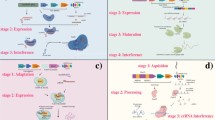Abstract.
Twenty-seven bialaphos-tolerant and GUS-positive lines were produced from 2,940 callus pieces after particle bombardment of wheat microspore-derived callus. Regenerated plants were mainly of the albino type. In an attempt to avoid this problem, wheat microspores were used as target cells for particle bombardment. Pre-cultivation for a period of 3–8 days improved the frequency of GUS-expressing microspores. Helium rupture pressures between 1,100 psi and 1,800 psi, the amount of gold per bombardment (ranging from 37 µg to 300 µg) and particle size (0.6–1.0 µg) did not significantly affect transient expression. Microspore response measured as number of recovered embryos was not significantly affected by variations in helium pressure or amount of gold used, but response was significantly influenced by particle size. The highest number of GUS-expressing embryos was 3.5 embryos per 106 microspores, which was obtained after 4 days of pre-cultivation, 1,350 psi rupture pressure, 0.6+1.0 µm particles (1:1) and 150 µg gold particles per bombardment.
Similar content being viewed by others
Author information
Authors and Affiliations
Additional information
Revizion received: 5 June 2001
Electronic Publication
Rights and permissions
About this article
Cite this article
Folling, L., Olesen, A. Transformation of wheat (Triticum aestivum L.) microspore-derived callus and microspores by particle bombardment. Plant Cell Rep 20, 629–636 (2001). https://doi.org/10.1007/s002990100371
Received:
Accepted:
Published:
Issue Date:
DOI: https://doi.org/10.1007/s002990100371




